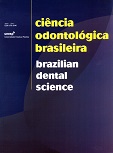Health problems due to dental practice at the public service of Campina Grande / PB / Brazil
DOI:
https://doi.org/10.14295/bds.2012.v15i1.740Palavras-chave:
Riscos Ocupacionais, Transtornos Traumáticos Cumulativos, OdontologiaResumo
The aim of this study was to identify health problems resulted from dental practice. The sample consisted of 32 dentists. A questionnaire comprising mainly objective questions was used. Data were analyzed descriptively and presented in tables. Most of the respondents were females (75%) and the predominant age range was 26-35 years (40.6%). Fifty-three point one percent of dentists had already suffered cutting and punching accidents during their activity. Considering the occupational diseases, 62.5% of participants had in the past or still present them, while the rest 37.5% of the participants have never had this type of disease. The most prevalent clinical complaint was muscle pain in lumbar region (65%), followed by pain in the spinal column (10%). Tendinitis (60%), varicose veins (40%) and presbyopia (40%) were the most prevalent diseases occasioned by the dental practice, according to the dentists. Therefore, in this study, most of the dentists working at the public health service in the city of Campina Grande (PB, Brazil) had undergone cutting and punching accidents, and most of them had or still present some occupational disease.
Downloads
Downloads
Publicado
Como Citar
Edição
Seção
Licença
TRANSFERÊNCIA DE DIREITOS AUTORAIS E DECLARAÇÃO DE RESPONSABILIDADE
Toda a propriedade de direitos autorais do artigo "____________________________________________________________________" é transferido do autor(es) para a CIÊNCIA ODONTOLÓGICA BRASILEIRA, no caso do trabalho ser publicado. O artigo não foi publicado em outro lugar e não foi submetido simultaneamente para publicação em outra revista.
Vimos por meio deste, atestar que trabalho é original e não apresenta dados manipulados, fraude ou plágio. Fizemos contribuição científica significativa para o estudo e estamos cientes dos dados apresentados e de acordo com a versão final do artigo. Assumimos total responsabilidade pelos aspectos éticos do estudo.
Este texto deve ser impresso e assinado por todos os autores. A versão digitalizada deverá ser apresentada como arquivo suplementar durante o processo de submissão.




























